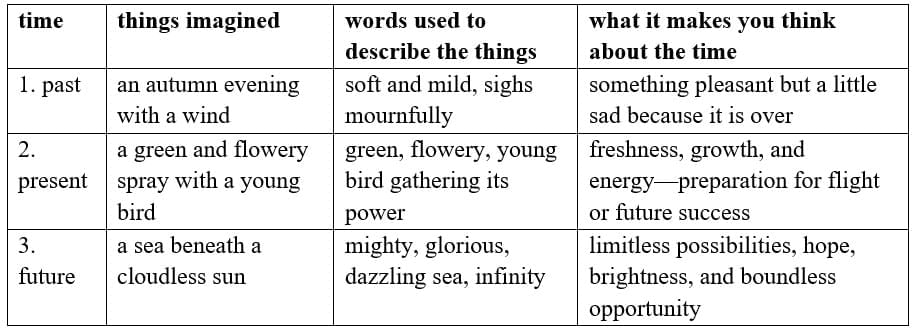Textbook Solutions: Past, Present, Future | Gul Mohar Class 6: Book Solutions, Summaries & Worksheets PDF Download
Before You Read
Look at these three words.
1. yesterday2. today
3. tomorrow
What do these words bring to your mind—a picture, a phrase, a song?
Tell the class. Do those pictures, phrases or songs feel particularly cheerful, sad or something else?
Ans:
- Yesterday brings to mind old memories and events that cannot return; often sad or nostalgic.
- Today suggests the present moment—lively, active, and hopeful.
- Tomorrow makes me think of dreams, goals, and the excitement of what is yet to come.
Understanding the Poem
Q. Complete this table.
Ans: 
Appreciating the Poem
Q1. Note whom the speaker is addressing in this poem.Ans: The speaker is addressing a child.
a. Which two words have been used to describe the child?
Ans: “Smiling child” and “happy one.”
b. Do the pictures imagined by the child match these descriptions of the child? Explain.
Ans: Yes. The child’s images are fresh, bright, and hopeful—like a smiling, happy imagination.
Q2. Examine the imagery presented in the three stanzas.
a. An Autumn evening soft and mild … Autumn is the season before winter when the days get shorter and the trees shed their leaves. Why do you think this season, with a sadly blowing wind, is the choice of image for the past?
Ans: Autumn represents the past because it’s a time when things are coming to an end, like leaves falling before winter. The sad wind reflects the feeling of something fading away, just like memories from the past.
b. Whom can the young bird represent in the second stanza? Why is it gathering its power?
Ans: The young bird represents youth or the present moment. It is gathering its power to prepare for the future, just like young people prepare for life ahead.
c. Why does the picture of the future show a ‘cloudless’ sun? Why does the sea stretch into ‘infinity’?
Ans: The cloudless sun represents a clear, hopeful future without obstacles, and the infinite sea symbolizes endless opportunities.
d. Could these pictures be imagined by anyone of any age, or do they sound particularly child-like?
Ans: They sound child-like because they are simple, fresh, and innocent, yet they can also appeal to people of any age because everyone thinks of time with such images.
Q3. In which stanza does the rhyme scheme differ from the other two stanzas? How does it differ?
Ans: The third stanza differs. The rhyme pattern changes with “sun” and “one” instead of following the same pattern as the first two stanzas.
|
30 videos|61 docs|17 tests
|
FAQs on Textbook Solutions: Past, Present, Future - Gul Mohar Class 6: Book Solutions, Summaries & Worksheets
| 1. What themes are commonly explored in the poem "Past, Present, Future"? |  |
| 2. How does the structure of the poem contribute to its meaning? |  |
| 3. What literary devices are used in the poem to enhance its expression? |  |
| 4. How can readers relate the poem's message to their own lives? |  |
| 5. What is the significance of time as a motif in the poem? |  |
|
30 videos|61 docs|17 tests
|














